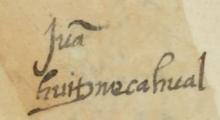Huitznecahual (MH501r)
This black-line drawing of the simplex glyph for the personal name Huitznecahual (perhaps "Abandoned Thorn," attested as a man’s name) shows a frontal view of two upright pointed thorns (huitztli). The -necahual part of the name does not appear to have a visual referent.
Stephanie Wood
Thorns or spines were instruments for bloodletting (tlacoquixtia), as the example from the Codex Mendoza (which simulates blood) suggests. The person with this name was probably named after the famous fifteenth-century ruler of Chalco, Huitznecahualtzin (in the reverential). Another Huitznecahual appears in the sixteenth-century Book of Tributes from Morelos (1993, 189), as published by Sarah Cline.
The -necahual part of the name may have the verb cahua (to leave behind) at its root. In The Nahuas (1992, 120), James Lockhart refers to a Magdalena Necahual as "Abandoned One." There may be an "n" that has dropped out of the -necahual part, given that Nenca and Nencauh are two names seen elsewhere in the Matrícula de Huexotzinco. These are both pejorative names. Perhaps the "n" is intrusive in those names. This all requires further research.
Stephanie Wood
Juā
huitznecahual
Juan Huitznecahual
Stephanie Wood
1560
Jeff Haskett-Wood
thorns, spines, espinas, abandoned, abandonados

huitz(tli), thorn, https://nahuatl.wired-humanities.org/content/huitztli
Huitznecahual, a Chalcan lord/ruler, https://nahuatl.wired-humanities.org/content/huitznecahual
Necahual, a name (sometimes female), https://nahuatl.wired-humanities.org/content/necahual
Matrícula de Huexotzinco, folio 501r, World Digital Library, https://www.loc.gov/resource/gdcwdl.wdl_15282/?sp=81&st=image
This manuscript is hosted by the Library of Congress and the World Digital Library; used here with the Creative Commons, “Attribution-NonCommercial-ShareAlike 3.0 License” (CC-BY-NC-SAq 3.0).



